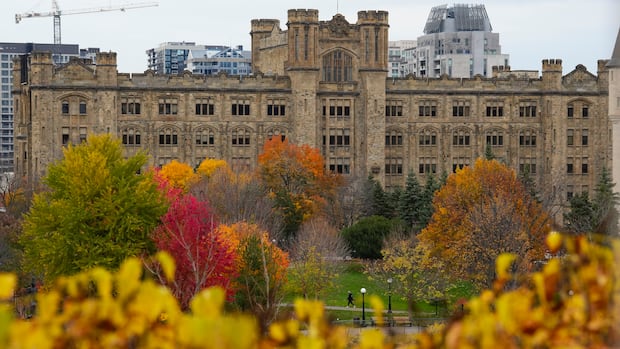Tuesday’s federal budget offers a glimpse into how dozens of government departments plan to rein in spending following this summer’s comprehensive expenditure review.The review aimed to find “ambitious savings” of up to 15 per cent over three years. The results were included with the budget, which still needs to pass a confidence vote.The budget includes $141 billion in new spending, offset by cuts and savings as the government hopes to slash the bureaucracy by 16,000 full-time equivalent positions over the next three fiscal years. It’s part of a larger goal to reduce the federal public service to 333,000 employees by 2029 — about 40,000 fewer workers than the all-time high in 2024. Job reductions are already underway, shrinking the bureaucracy by about 10,000 employees since last year. While the budget doesn’t detail where the job cuts will happen, it does break down how some departments plan to tighten their belts leading up to 2030. Not all departments were included in the review submissions.Housing, Veterans Affairs and the Canada Revenue Agency came up with some of the biggest savings, ranging from $4.1 billion to $5.4 billion, but the impact will vary depending on the size of each department’s budget.Here’s a breakdown, with the total savings estimated for the next four fiscal years:AgricultureCRACanadian HeritageEmployment and Social DevelopmentEnvironment and Climate ChangeFinanceFisheries and Oceans Global AffairsHealthHousing, Infrastructure and CommunitiesImmigration, Refugees and CitizenshipInnovation, Science, and IndustryJusticeNational DefenceNatural ResourcesPrivy CouncilPublic SafetyPublic Services and ProcurementTransportTreasury BoardVeterans AffairsAgriculture: $507MAgriculture and Agri-Food Canada will “reorient” its programs and operational expenses to align with government priorities, the budget states. It’s shutting down some programs such as the Agricultural Climate Solution Living Labs. It will also reduce some science activities to become more cost-effective in the long term, but says it will continue work in such areas as crops and horticulture, animal production and environmental sustainability.CRA: $4.1BThe Canada Revenue Agency (CRA) is closing down some programs including the Digital Services Tax, Federal Fuel Charge and Canada Carbon Rebate.The budget also proposes to eliminate “the inefficient Underused Housing Tax” and luxury tax on aircraft and vessels, which CRA says will help save administration costs. The agency says a portion of these savings will be reinvested to improve services for Canadians, strengthen compliance and reduce tax debt. CRA is among several departments planning to lean into AI to free up staff resources to address the tax debt backlog.”By automating certain tasks in the risk scoring process, CRA estimates that repetitive tasks will be reduced by 50 per cent once fully implemented,” the budget document reads.The Canada Revenue Agency says a portion of its savings will be reinvested to improve services to Canadians, strengthen compliance and reduce tax debt. (Félix Desroches/CBC)Canadian Heritage: $270MCanadian Heritage says it will reduce its Canada Cultural Spaces Fund.It will no longer fund paid subscriptions or single-copy sales from the Canada Periodical Fund, refocusing it to incentivize creation of original Canadian editorial content only.The department will also transform its transfer payment delivery model, replace broken systems and close the Gift Bank for Ministers and senior officials. The Canadian Radio-television and Telecommunications Commission will also use AI to make its Spam Reporting Centre more cost-effective.Employment and Social Development: $2.2BEmployment and Social Development Canada says it’s going to reduce its property portfolio by cutting office space, use fewer consultants, and limit travel and conferences. It will also increase its use of AI.The department is shifting funding away from underperforming programs, and is consolidating the Canada Service Corps and the Supports for Student Learning program to lower administration costs.Environment and Climate Change: $1.1BEnvironment and Climate Change Canada will end some small lease agreements, cut external training contracts, and slash activities and programs that aren’t within its core mandate. It will also consolidate its work on Indigenous engagement.Finance: $89MThe Finance Department is looking to cut travel, printing, hospitality and office expenses, while shifting toward AI research tools. It also plans to make “structural realignments.”Fisheries and Oceans: $544MThe Department of Fisheries and Oceans (DFO) will wind down some research and monitoring activities, scale back programs, and reduce management and internal services. It plans to use AI and other digital tools to “modernize Canada’s fisheries management system,” and says using less paper will free up officers to spend more time in communities and enforcement.DFO is also planning to reduce reviews and formal authorizations required for routine, low-risk projects, focusing instead on higher-risk projects that impact fish and habitats.Global Affairs: $3.6BGlobal Affairs Canada (GAC) is reducing development funding for global health programs, saying Canada’s contributions have been disproportionately high compared to other countries. Other overseas development programs will also be reduced to meet pre-COVID levels.GAC plans to reform its trade and investment portfolio, and aims to reduce mission expenses by consolidating embassies to fewer buildings.The Canadian Embassy in Washington, D.C., is pictured in March 2025. Global Affairs says it’s hoping to consolidate some of its embassies with other properties. (Evan Angelovski/CBC)Health Canada: $649MHealth Canada says it’s selected a few programs that are in low demand or provide minimal health benefits. It will also “recalibrate internal science and research activities.”Housing, Infrastructure and Communities: $5.4BHousing, Infrastructure and Communities Canada boasts one of the largest cost savings, partly because its portfolio includes planned cuts by the Canadian Mortgage and Housing Corporation (CMHC). The department says its goal is to streamline management and operations. It’s also looking to reduce funding available under the Canada Housing Infrastructure Fund and the Canada Public Transit Fund, a federal transit fund which some municipalities were promised to help bolster public transit infrastructure. Meanwhile, budget 2025 highlights a new federal agency, Build Canada Homes, to “supercharge” the housing industry with an initial investment of $13 billion over five years.”Build Canada Homes provides an opportunity to re-evaluate CMHC’s resources and programming to ensure they are aligned with this important priority,” the budget states.CMHC will wind down several programs that don’t increase housing supply, or that fall under the Build Canada Homes objectives.Immigration, Refugees and Citizenship: $2.1BImmigration, Refugees and Citizenship Canada (IRCC) is making “targeted adjustments” to programs such as the Interim Housing Assistance Program (IHAP), which helps provinces, municipalities and non-profits support and house asylum claimants. To reduce duplication, IRCC is transferring compliance inspections for employers who hire temporary foreign workers to the International Mobility Program to the Department of Employment and Social Development, which already conducts similar inspections.Immigration, Refugees and Citizenship Canada is transferring some tasks to other departments and adjusting other programs to save money. (Ivanoh Demers/CBC)IRCC is also limiting program eligibility for economic immigrants, and is introducing a co-pay model to its Interim Federal Health Program, which provides health coverage to asylum claimants, refugees and other protected people.The department is also looking to further rely on technology, reduce consultant contracts and revisit staffing levels.Innovation, Science, and Industry: $3.4BInnovation, Science and Economic Development Canada is winding down some programs. Due to low demand, it’s not renewing certain funding envelopes in the Global Innovation Clusters and the Strategic Innovation Fund.It plans to reduce specialized personnel, and rely less on outside consultants.It’s also transferring the Canadian Small Business Financing Program to the Business Development Bank of Canada.Statistics Canada is hoping to lean more on automation and new tools to make its operations more efficient. (Justin Tang/Canadian Press)Statistics Canada hopes to save $338.9 million over the next four fiscal years. It’s looking to reduce the frequency of data collection and limit the collection of information that it sees as less relevant to Canadians. It’ll also look at flattening management layers, and hopes to lean more on new tools, technology and automation to improve workflow.Justice: $184MThe Justice Department wants leaner management, and will invest in AI to address the growing demand for legal services.It’s also hoping to adjust informal procedures for income tax and GST appeals at the Tax Court.National Defence: $1.9BThe Department of National Defence (DND) was given a savings target of just two per cent savings target, as the budget prioritized significant defence spending.As part of that effort, it’s retiring some fleets that are costly to maintain. DND is also looking to sell off or transfer underutilized, obsolete or surplus properties. Where appropriate, some could be repurposed by other levels of government or the private sector.It’s also planning to retrofit its defence facilities with energy-efficient systems.Natural Resources: $1.9BNatural Resources Canada (NRCan) is planning to wind down several programs like the Canada Greener Homes Grant and the 2 Billion Trees program.NRCan says it will prioritize its science mandate, and will cut down on its operations of the Office of the Surveyor General in the North. Privy Council: $117MThe Privy Council Office is going to automate external correspondence and consolidate its human resources, finances and IT services. It’s also revisiting programs that are “no longer a priority,” singling out the Clean Growth Office and the program for Public Lands and Housing.Public Safety: $97MPublic Safety and Emergency Preparedness Canada says it’s going to become “leaner.” That means cutting executive and administrative roles, and using AI. It’s also cutting services that it believes have minimal impact, such as the Centre for Resilience and Continuity Management and the Public Safety Library.A CBSA officer is photographed at Pearson International Airport in Toronto in 2021. (Evan Mitsui/CBC)The Canada Border Services Agency (CBSA) was also given a two per cent reduction target. It hopes to save $208 million by 2030.CBSA plans to decommission old software applications and reduce the pace vehicle replacement. It’s also reviewing the staff structure at its national headquarters, cutting travel and training costs and reviewing overtime spending. CBSA says the proposed savings won’t impact border security.Public Services and Procurement: $642MPublic Services and Procurement Canada (PSPC) is also looking to downsize management, and says it will cut costs on professional services and travel.It will also implement AI chat bots and self-service tools. PSPC plans to sunset activities with the Canada General Standards Board, and will reduce funding to pilot innovation projects for Laboratories Canada. Shared Services Canada hopes to save $1 billion in the next four fiscal years. It will retire outdated technologies and shrink the government’s “costly legacy IT footprint.” It’s also going to cut spending on external consultants and contractors.Transport: $1.4BTransport Canada is phasing out or reducing some of its overlapping programs that can be better handled by other departments. For example, the program that provides incentives for medium- and heavy-duty zero-emission vehicles will shut down by next year.It also plans to restructure its regional offices and reduce the layers of management. Its aviation services will transfer most of its core services to National Defence, the budget states.Transport Canada is among the departments deploying advanced technology and AI where possible.The Canadian Air Transport Security Authority (CATSA) will deploy automated systems to detect prohibited items at screening. It hopes to save $160 million by 2030. Treasury Board: $217MThe Treasury Board of Canada Secretariat (TBS) says it’s returning to its “core business functions.” It plans to combine teams, trim management and administrative support, and leverage automation. TBS says it will wind down temporary funding for the Enterprise Cyber Security Strategy, and adjust its involvement in the Low Carbon Fuel Production program.Veterans Affairs: $4.2BVeterans Affairs Canada is also making some changes, including reducing its medical cannabis reimbursement rate from $8.50 per gram to $6 per gram, to better reflect current market prices.Back to top
Monday, 22 Dec 2025
Canada – The Illusion
Search
Have an existing account?
Sign In
© 2022 Foxiz News Network. Ruby Design Company. All Rights Reserved.
You May also Like
- More News:
- history
- Standing Bear Network
- John Gonzalez
- ᐊᔭᐦᑊ ayahp — It happened
- Creation
- Beneath the Water
- Olympic gold medal
- Jim Thorpe
- type O blood
- the bringer of life
- Raven
- Wás’agi
- NoiseCat
- 'Sugarcane'
- The rivers still sing
- ᑲᓂᐸᐏᐟ ᒪᐢᑿ
- ᐅᑳᐤ okâw — We remember
- ᐊᓂᓈᐯᐃᐧᐣ aninâpêwin — Truth
- This is what it means to be human.
- Nokoma











